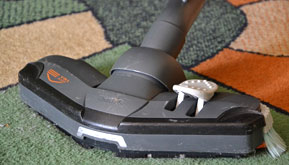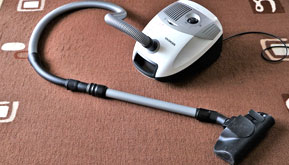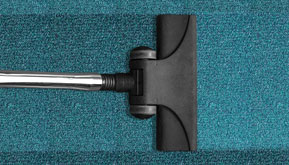The sound of a typical Saturday morning general cleaning in homes isn’t complete without the noise of a vacuum cleaner or simply vacuum. It’s a household necessity tasked with sucking up dust and grime with convenience and efficiency. Have you ever wondered how this cleaning machine started?
 History of the Vacuum
History of the Vacuum
Devices mostly started with something so basic. For the vacuum, the broom is its starting point. When people began seeking a less tedious, more efficient, and more advanced way of cleaning, mechanical sweepers were invented. English inventors patented their sweepers that cleaned floors, carpets and streets. In 1859, Hiram Herrick of Boston filed for the first American patent for a carpet sweeper, which was basically a rolling broom and dustpan.
The next year, Daniel Hess of Iowa created the first mechanical device for cleaning floors: a carpet sweeper with a rotating brush and bellows which generated suction. Hess earned the patent for this first rudimentary design for the modern vacuum cleaner.
The very first vacuum was invented by Ives W. McGaffey in Chicago in 1868. It was called the “Whirlwind,” which had to be used with a hand crank while pushing it across the floor. However, the Whirlwind was unsuccessful because of it was expensive and was harder to use than a simple broom. The models were mostly marketed throughout Chicago, but much of the inventory was destroyed because of two factory fires in 1872.

People tried to improve Thurman’s creation. In 1901, an English structural engineer Hubert Cecil Booth introduced the first powered vacuum known as the “Puffing Billy.” The device was first powered by an oil engine, but later by an electric motor. Booth landed high-profile jobs with it, as he was commissioned to clean the Westminster Abbey for the coronation of King Edward VII and Queen Alexandra in 1902. The Puffing Billy impressed the royal couple, and they purchased these machines for the Windsor Castle and the Buckingham Palace. Eventually, Booth’s device was being built into the homes of the rich, in hotels and in high-rise buildings in New York.
Meanwhile, an American inventor David T. Kenney also invented a vacuum that used a suction in 1901. His device was a stationary 4,000-pound steam engine powered system with hoses and pipes reaching into all parts of the building.
Due to the huge size and large expense of owning a vacuum, this cleaning device was limited for use in huge houses and establishments, not for ordinary family use. The first vacuum cleaning machine that could be carried around was built in 1905 by Walter Griffiths of Birmingham, England. It used bellows to suck up dust through a flexible pipe. In 1906, James Kirby invented the first vacuum machine that used water for dirt separation instead of a filter and called it the “Domestic Cyclone.”
Allergies somehow played a role in revolutionizing the cleaning machine. The first portable, electric vacuum with a motor was designed by Ohio janitor James Murray Spangler in 1907. Due to the constant asthma attacks he experienced using his sweeper, Spangler decided to create an electric vacuum using an electric fan motor, a broom handle, a soapbox and his wife’s pillowcase. He added a rotating brush to loosen dirt. The crude machine worked well and he patented it in 1908. He quit his job and opened the Electric Suction Sweeper Company, with a $5,000 investment from a friend.

Hoover turned Spangler’s invention into a business success. Most people associated the vacuum with him, rather than with Spangler. At some point, people even called the action of vacuuming as “hoovering.” Since Hoover acquired the patents, there have been helpful improvements with the machine. He redesigned it by placing it in a steel box and created assorted designs of attachments for the hose. In the 1920s, disposal filter bags were added and in 1926, the first upright vacuum was created.
The vacuum was a luxury at first, but when it became affordable by middle class families after the second World War, the device slowly became a part of many households. Many types and sizes of vacuums were developed, with some that use filters and some that clean through cyclonic separation.

By the turn of the century, more high-technology vacuumss were developed. In 2002, a robotic vacuum cleaner named Roomba entered the market. This vacuum can set on the floor and roam around freely while sucking up dirt and dust, and avoids bumping to things with the help of detectors.
Benefits of Vacuums
One type of vacuum could give users certain advantages over another, but basically, all vacuum cleaners offer these benefits:
1. Makes cleaning more effective.
Sweeping alone cannot remove dirt and dust easily, especially in surfaces like rugs, carpets and window screens. Particles like pet hair would be more effectively removed by a vacuum. Some vacuum cleaners have the capacity to wash carpets, and some lets off steam to disinfect surfaces.
2. Saves time and effort.
If you have a house with two to three floors and multiple bedrooms, cleaning it entirely would take you hours and make you tired. Using an automatic vacuum cleaner would reduce your cleaning time and do all the sucking of dirt and grime for you.
3. Saves money.
Proper maintenance of carpets and rugs will make them last longer, so regular vacuuming can help you lessen costs on replacing them.
4. Protects health.
Vacuum cleaning improves indoor air quality, thus protecting your household from dust and microbes that can trigger allergies and cause diseases.


 History of the Vacuum
History of the Vacuum